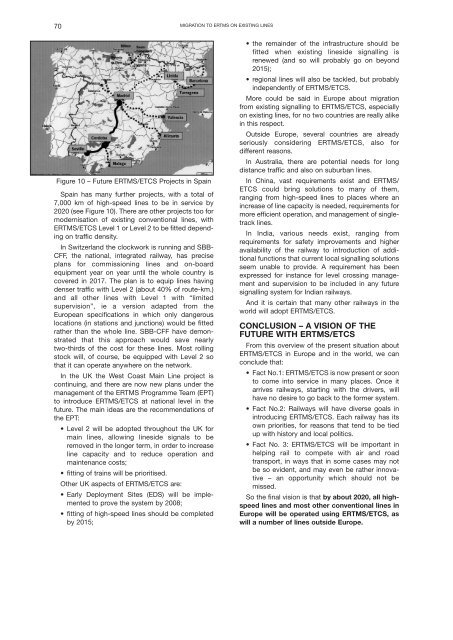Proceedings 2002/2003 - IRSE
Proceedings 2002/2003 - IRSE
Proceedings 2002/2003 - IRSE
Create successful ePaper yourself
Turn your PDF publications into a flip-book with our unique Google optimized e-Paper software.
70<br />
MIGRATION TO ERTMS ON EXISTING LINES<br />
Figure 10 – Future ERTMS/ETCS Projects in Spain<br />
Spain has many further projects, with a total of<br />
7,000 km of high-speed lines to be in service by<br />
2020 (see Figure 10). There are other projects too for<br />
modernisation of existing conventional lines, with<br />
ERTMS/ETCS Level 1 or Level 2 to be fitted depending<br />
on traffic density.<br />
In Switzerland the clockwork is running and SBB-<br />
CFF, the national, integrated railway, has precise<br />
plans for commissioning lines and on-board<br />
equipment year on year until the whole country is<br />
covered in 2017. The plan is to equip lines having<br />
denser traffic with Level 2 (about 40% of route-km.)<br />
and all other lines with Level 1 with “limited<br />
supervision”, ie a version adapted from the<br />
European specifications in which only dangerous<br />
locations (in stations and junctions) would be fitted<br />
rather than the whole line. SBB-CFF have demonstrated<br />
that this approach would save nearly<br />
two-thirds of the cost for these lines. Most rolling<br />
stock will, of course, be equipped with Level 2 so<br />
that it can operate anywhere on the network.<br />
In the UK the West Coast Main Line project is<br />
continuing, and there are now new plans under the<br />
management of the ERTMS Programme Team (EPT)<br />
to introduce ERTMS/ETCS at national level in the<br />
future. The main ideas are the recommendations of<br />
the EPT:<br />
• Level 2 will be adopted throughout the UK for<br />
main lines, allowing lineside signals to be<br />
removed in the longer term, in order to increase<br />
line capacity and to reduce operation and<br />
maintenance costs;<br />
• fitting of trains will be prioritised.<br />
Other UK aspects of ERTMS/ETCS are:<br />
• Early Deployment Sites (EDS) will be implemented<br />
to prove the system by 2008;<br />
• fitting of high-speed lines should be completed<br />
by 2015;<br />
• the remainder of the infrastructure should be<br />
fitted when existing lineside signalling is<br />
renewed (and so will probably go on beyond<br />
2015);<br />
• regional lines will also be tackled, but probably<br />
independently of ERTMS/ETCS.<br />
More could be said in Europe about migration<br />
from existing signalling to ERTMS/ETCS, especially<br />
on existing lines, for no two countries are really alike<br />
in this respect.<br />
Outside Europe, several countries are already<br />
seriously considering ERTMS/ETCS, also for<br />
different reasons.<br />
In Australia, there are potential needs for long<br />
distance traffic and also on suburban lines.<br />
In China, vast requirements exist and ERTMS/<br />
ETCS could bring solutions to many of them,<br />
ranging from high-speed lines to places where an<br />
increase of line capacity is needed, requirements for<br />
more efficient operation, and management of singletrack<br />
lines.<br />
In India, various needs exist, ranging from<br />
requirements for safety improvements and higher<br />
availability of the railway to introduction of additional<br />
functions that current local signalling solutions<br />
seem unable to provide. A requirement has been<br />
expressed for instance for level crossing management<br />
and supervision to be included in any future<br />
signalling system for Indian railways.<br />
And it is certain that many other railways in the<br />
world will adopt ERTMS/ETCS.<br />
CONCLUSION – A VISION OF THE<br />
FUTURE WITH ERTMS/ETCS<br />
From this overview of the present situation about<br />
ERTMS/ETCS in Europe and in the world, we can<br />
conclude that:<br />
• Fact No.1: ERTMS/ETCS is now present or soon<br />
to come into service in many places. Once it<br />
arrives railways, starting with the drivers, will<br />
have no desire to go back to the former system.<br />
• Fact No.2: Railways will have diverse goals in<br />
introducing ERTMS/ETCS. Each railway has its<br />
own priorities, for reasons that tend to be tied<br />
up with history and local politics.<br />
• Fact No. 3: ERTMS/ETCS will be important in<br />
helping rail to compete with air and road<br />
transport, in ways that in some cases may not<br />
be so evident, and may even be rather innovative<br />
– an opportunity which should not be<br />
missed.<br />
So the final vision is that by about 2020, all highspeed<br />
lines and most other conventional lines in<br />
Europe will be operated using ERTMS/ETCS, as<br />
will a number of lines outside Europe.

















